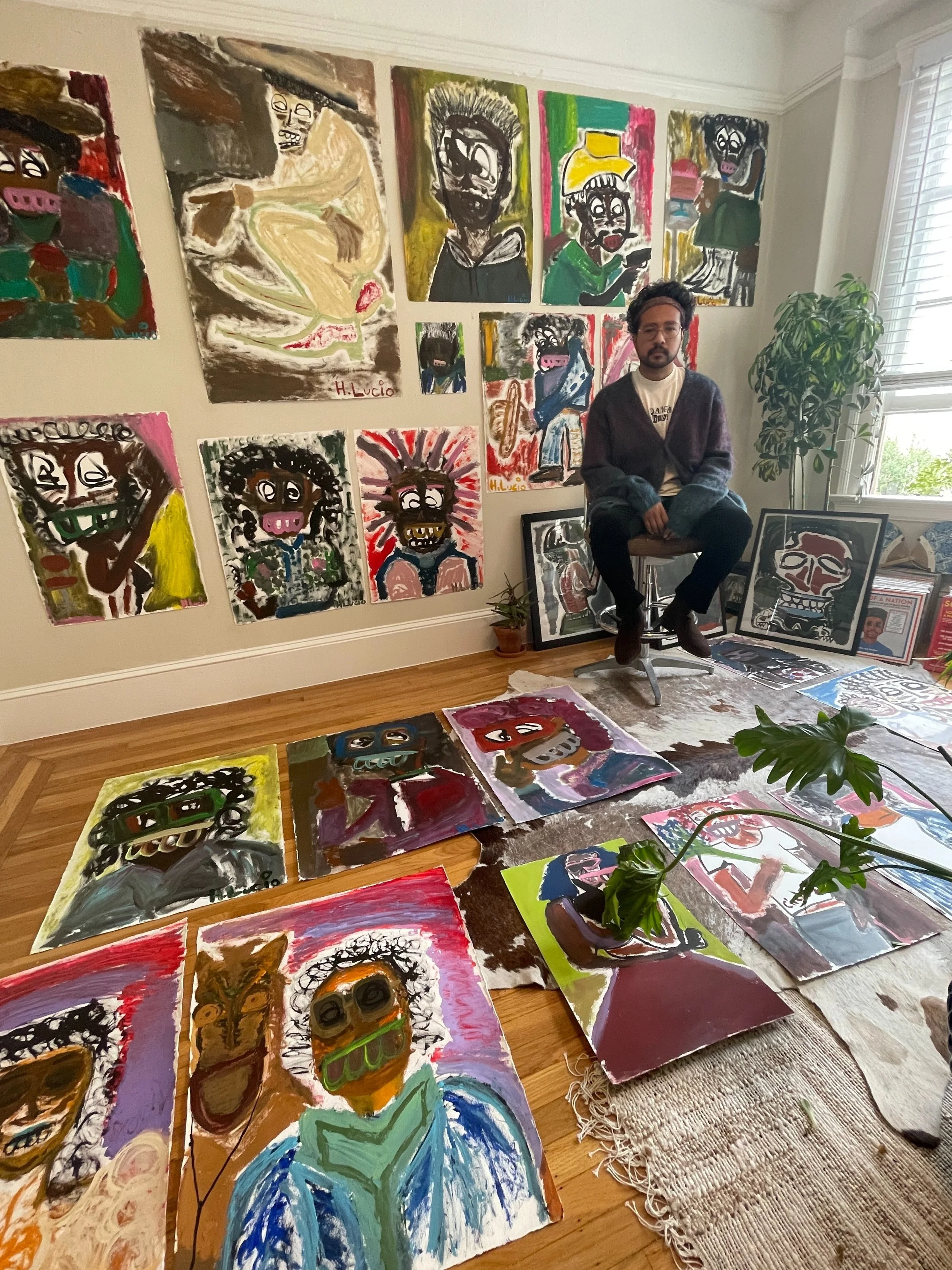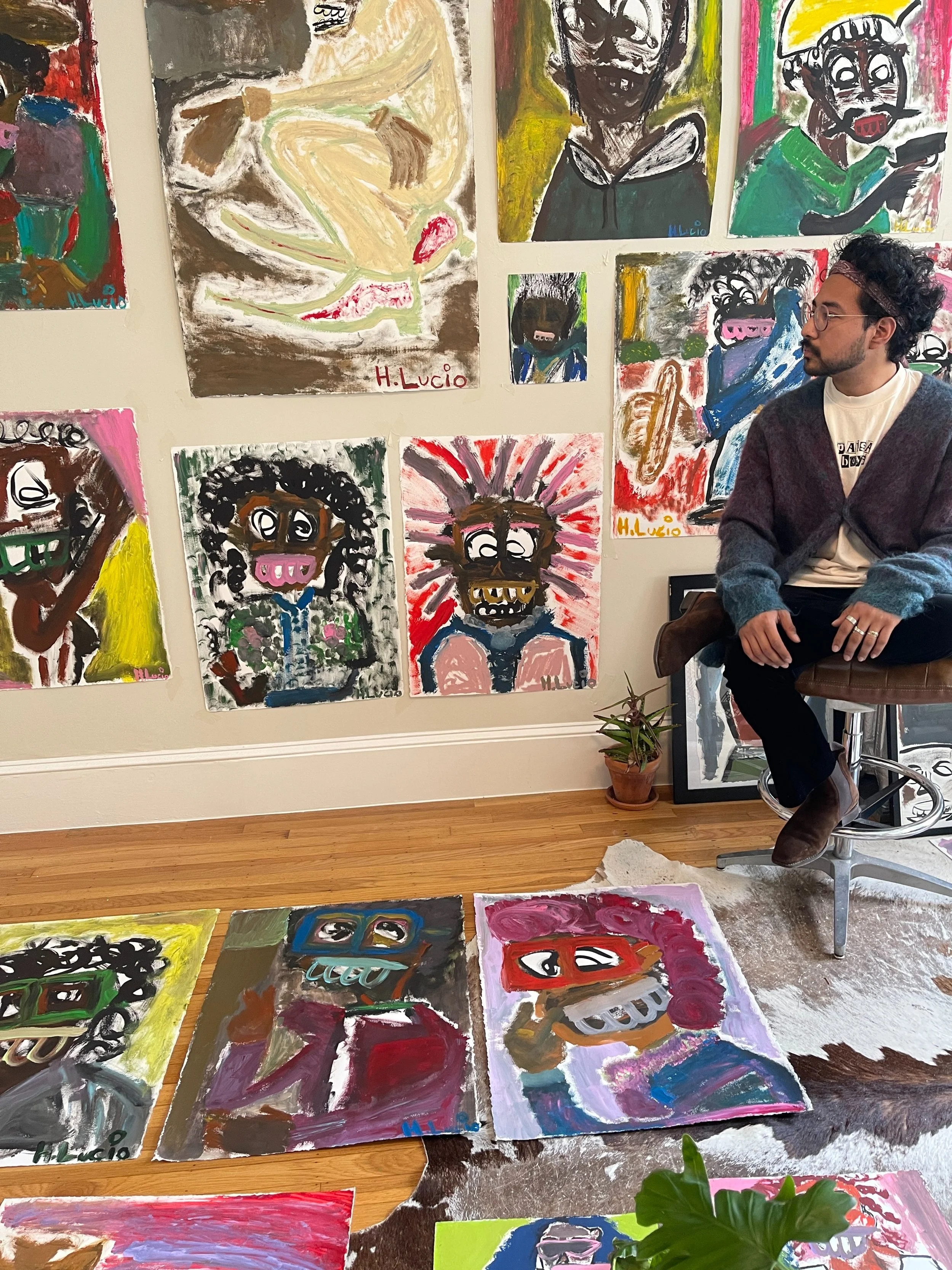Studio Visit & Interview with Hebert Lucio
By John Vochatzer
Of all the new local artists I’ve discovered since opening a gallery space in the Tenderloin, one that I’ve particularly had my eye on and been drawn to is Hebert Lucio. I first discovered his work on Instagram around a year ago, which he shares interspersed with fashionable portraits of himself in various San Francisco and other California locations. His art is minimal, intuitive, and most of all prolific, but it wasn’t until I had the pleasure of visiting his studio here downtown recently that I got to see the incredible range of scope of the work and to learn more about it’s more profound and socially charged origins.
Growing up in Echo Park, Los Angeles, and moving to the Bay Area to pursue his goals as an artist, Hebert’s vast catalogue of painting and pastel work centers around depictions of the often more marginalized and forgotten members of both of these locales. His most recent series “Vida Americana” strives to give voice and acknowledgement to these individuals and to create an engagement in doing so. In our interview we also talked about this transition from Southern to Northern California, about some of Hebert’s other projects and series, and about what artists he’s found particularly influential to himself and his work. Enjoy!
Interview
What can you tell us about the current series you’re working on, “Vida Americana”?
“Vida Americana” explores what the American dream looks like in California, from Echo Park in Los Angeles to the Tenderloin in San Francisco. A man wears a Dodgers hat, holding a green card. A cowboy crouches on the ground with elongated boots made in San-Luis Potosi. A woman dons a quinceañera-like dress. This series, and a lot of my work in general, gives a personal dimension to immigration and internationalism. It subverts sound bites, caricatures and news reports. My work is what I’ve seen and lived. I want to let people who have experienced something similar see themselves on a gallery or museum wall, not just for representation but for conversation, thought, joy, sorrow, even emptiness.
Place is obviously an important part of your work. How has living in both Los Angeles and San Francisco, and the transition from one place to the other, directly impacted you as an artist?
I grew up in Los Angeles, and spent a lot of time in Echo Park in the 1990s. It was seedy, but it never actively felt like a “war zone” or a center for gang violence. It just felt like a neighborhood where I could hang out with my friends, similar to the Tenderloin. The people who live in the Tenderloin look like me. The Tenderloin has a similar reputation and nature as ’90-era Echo Park, but I never feel out of place or unwelcome in the Tenderloin because it’s a place that’s welcoming. Most people don’t see that side of the neighborhood. I feel comfortable enough to draw inspiration from both Echo Park and the Tenderloin, to find comfort in the chaos. In LA, my work was fluid and impermanent, because that’s what I appreciated at the time. When I relocated to the Tenderloin, I found myself inspired to make permanent work that really engaged with my surroundings.
Can you talk about the work that first came out of you living in the Tenderloin?
"Natural Smile," which was my first series, explores disenfranchisement, the promises and limitations of the American dream, and the clash of politics and cultural identity. I started working on it soon after moving to the TL from Oakland. The series analyzes daily life in the Tenderloin, reclaiming the smile within the neighborhood’s homeless, desperate and struggling inhabitants with the goal of humanizing them as well as myself. This was also the work I showed at my first solo exhibition at The Family Room in 2018 for the Tenderloin Art Walk. For the exhibition of “Natural Smile” I wanted to create an experience. We handed out around fifty pre-rolled joints because I wanted everyone to see the work in the way that I made it—with a joint, always in motion. I also rented a U-Haul and parked it in front of the gallery space, hung up lights and more work within it and decorated it loosely like a living room. I didn’t really expect more than twenty people to show up, but a lot of people I did and didn’t know stopped by. And we definitely ran out of joints.
How did it feel to see people engage with your work?
The best part about that show was getting to see people look at my work and be reminded of themselves to some degree. I enjoyed seeing people connect with my work without having any context of me or what the work was about.
Most of your pieces feature people as the subject, but you have said that you don’t consider your work to be portraiture. What exactly gives you pause about that definition?
The “masters” of Western art historically have used portraiture to portray certain ideologies. My work is not a reinterpretation of portraiture in the Western art canon. It’s what – and who – they missed: the people who were in the corner, the people whose skin tone disturbed the work, the people Western artists considered simply negative space. That’s how I view my art.
Other than “Natural Smile” and “Vida Americana,” have you created any other series?
After “Natural Smile” I worked on “American Icons: Winter In America,” which explores the relationship between rock'n'roll, history and American society. Rock'n'roll was once a lifestyle born from mainstream rebellion, a musical movement informed by historical events that in turn shaped culture as we know it. As today's counter-culture aesthetically and culturally embraces rock'n'roll without acknowledging its roots, the echo of independence, creative individuality and uncensored self-expression begins to fade. I wanted to look at the influence of icons like David Bowie, Jimi Hendrix, Kurt Cobain, James Brown, Grace Jones, Michael Jackson, Miles Davis and Amy Winehouse. I showed this work at my second solo exhibition in 2019, at John Varvatos San Francisco.
“International Jazz” is my third series, which focuses on a number of significant geopolitical events within U.S immigration. It examines imbalanced power structures, the media and government-constructed identities that are forced upon people of color, and the shared experiences of pain that can lead to better understanding one another.
The title of this series directly reflects the similarities I see between politics and jazz. Throughout history, certain events become reduced to sound bites, headlines and snippets of (often forgotten) information. As history repeats itself and these sound bites reemerge, it’s similar to recurring phrases in jazz that bounce between musicians.
What artists do you consider yourself influenced by and/or in conversation with?
Forever Kerry James Marshall. Michael Jang. Nam June Paik – the first piece I ever saw by him was “Warez Academy” at the Honolulu Museum of Art Spalding House campus and that experience was quintessential to the development of my work. Barbara Sánchez-Kane. Jeffrey Cheung. Enrique Chagoya, whose work I was just reintroduced to. Gordon Parks.















